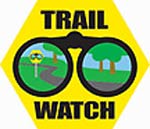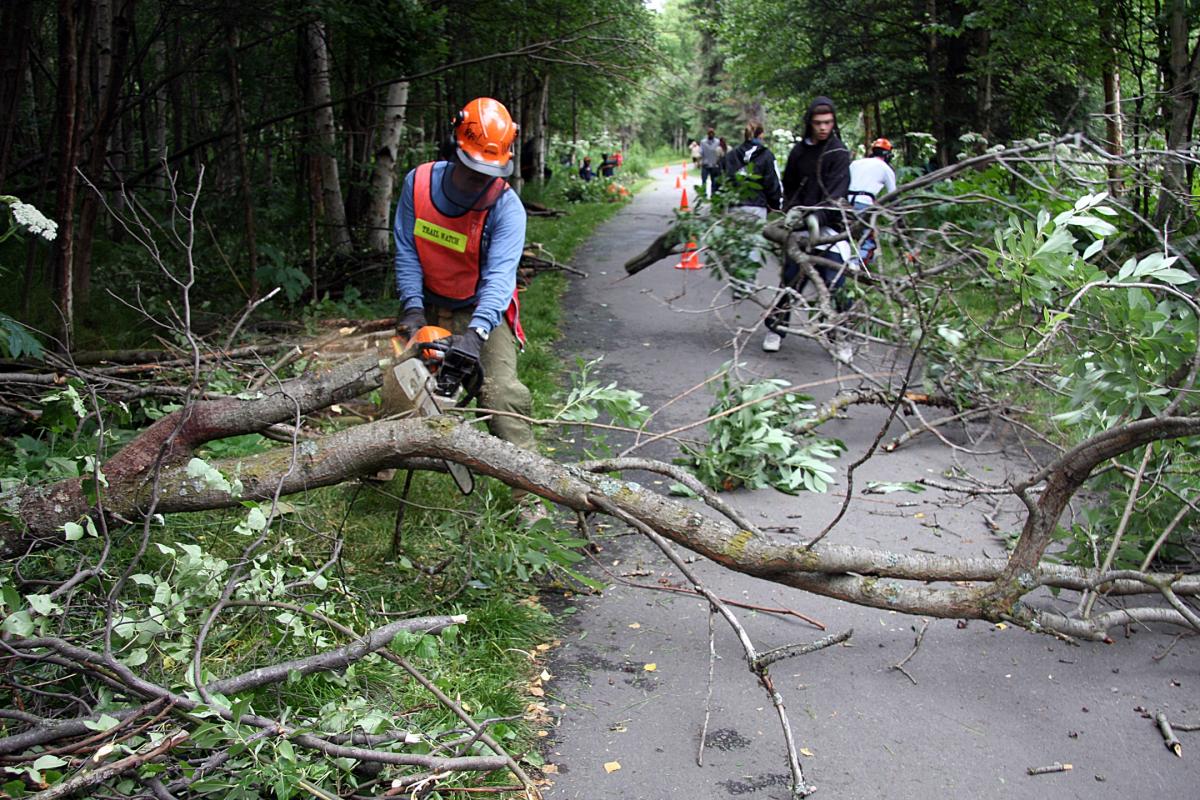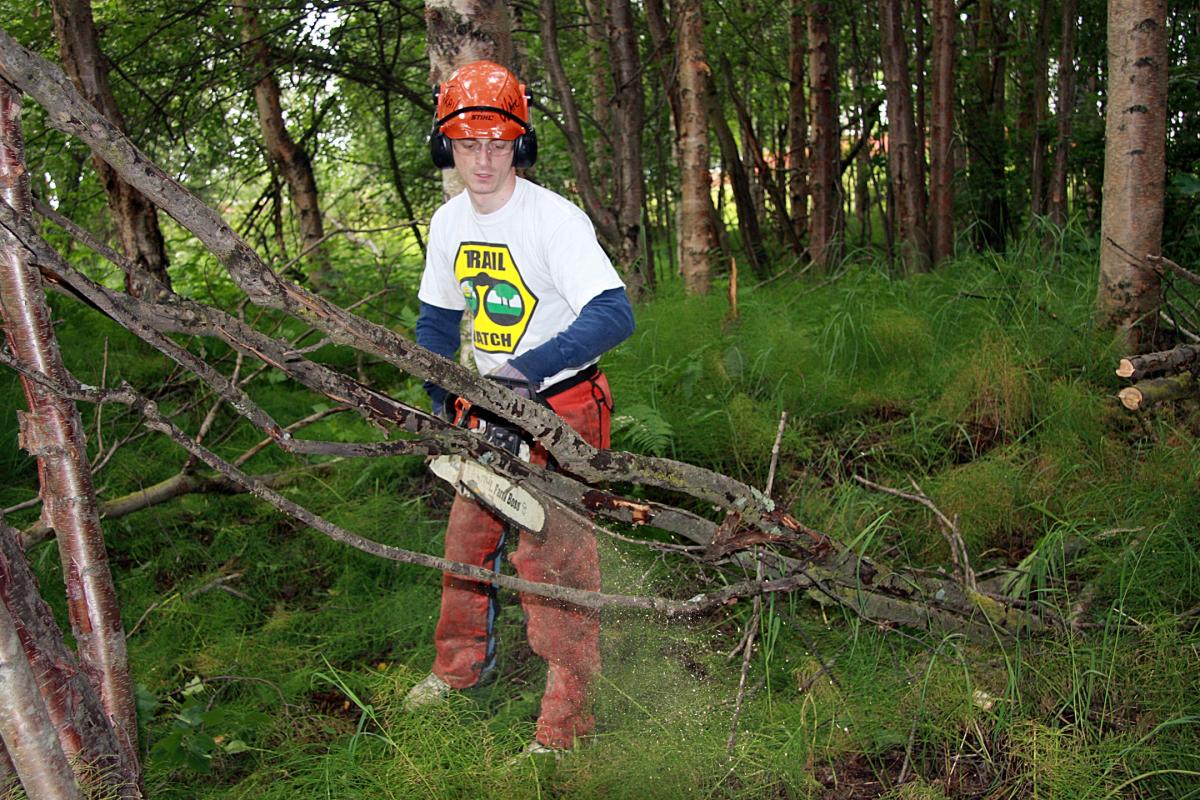Safety on the Move: Anchorage Trail Watch
Program blazes a clear path for the city’s hikers, bikers, and runners
 Trails have multiple values and their benefits reach far beyond recreation. Trails can enrich the quality of life for individuals, make communities more livable, and protect, nurture, and showcase America’s grandeur by traversing areas of natural beauty, distinctive geography, historic significance, and ecological diversity. Trails are important for the nation’s health, economy, resource protection, and education. — AMERICAN TRAILS, Trails for All Americans report, 1990
Trails have multiple values and their benefits reach far beyond recreation. Trails can enrich the quality of life for individuals, make communities more livable, and protect, nurture, and showcase America’s grandeur by traversing areas of natural beauty, distinctive geography, historic significance, and ecological diversity. Trails are important for the nation’s health, economy, resource protection, and education. — AMERICAN TRAILS, Trails for All Americans report, 1990
Anchorage — known fondly as the City of Lights and Flowers — boasts an award-winning trail network that offers awe-inspiring views of some of the nation’s most breath-taking scenery. More than 294 miles of paved and unpaved trails wind through the city’s urban center, wrap around coastline neighborhoods, and stretch into the foothills of nearby Chugach State Park. Keeping this extensive trail network free of crime and physical hazards is a never-ending and demanding task. The Municipality of Anchorage has successfully met this challenge through the adoption of an innovative community-based program called Trail Watch.
Program Background
Trail Watch is based on the same principle as Neighborhood Watch—that bringing community members together to re-establish control of their neighborhoods promotes an increased quality of life and reduces the crime rate in that area. Although Trail Watch members do not necessarily reside in the same neighborhoods, they share a common love of and vested interest in the health and welfare of the city’s green spaces.
The Anchorage Mayor’s Office began development of the Trail Watch program on August 1, 2003, in response to a series of assaults on female joggers that had taken place the previous June and July. City planners began by conducting a series of meetings and interviews with individual trail users and local outdoors organizations, which revealed several common safety concerns. Topping the list of issues mentioned were poor lighting and overgrown vegetation. Respondents also noted that a lack of signs, maps, and markers made it difficult for trail users to navigate and, if injured or victimized, correctly articulate their location to emergency responders. Complicating matters, law enforcement acknowledged an inability to accurately track the number of incidents occurring on Anchorage trails due to a deficiency in the reporting system.
Despite these concerns, respondents also revealed that they felt strongly about particular parts of the trail system, and many stated that they used certain trails daily. These users expressed a willingness to take an active role to keep the trail network safe and well maintained. Based on initial findings from the interviews, it became clear that Trail Watch would require a strong community-based core. When the program was officially launched in September 2003, it focused on five goals: establishing volunteer patrols, enhancing signage, enhancing trail visibility, improving the trail maintenance reporting system, and developing a better crime reporting and tracking system.
Hitting the Trails

Volunteers use the Trail Watch website to submit online summaries of trail conditions (warning the community of icy bridges and flooded paths, for example) and to immediately report maintenance issues such as erosion, graffiti, and broken lighting, which allows Anchorage Department of Parks and Recreation authorities to respond more quickly. Like their Neighborhood Watch counterparts, Trail Watchers and Ambassadors do not confront or arrest suspects but serve as the extra “eyes and ears” of the trail system—a visible presence that helps deter crime and ensure public safety.
Making Up: A Community Effort

Trail Watch safety makeovers also help reduce the likelihood of a face-to-fang encounter with one of the region’s four-legged denizens. Bordered on the west, north, and south by the Cook Inlet, and to the east by the Chugach Mountains, Anchorage teems with wildlife. Streams bisect several city parks, and during salmon spawning season, it is common to see bears foraging along the banks in search of an easy meal. During the rutting and calving seasons, both bears and normally placid moose can become aggressive toward humans. Just this past June, an Anchorage bicyclist commuting to work received nonlife-threatening bites and scrapes when he unwittingly startled a mother bear protecting her cub. At least eight bear maulings occurred in the summer of 2008, the most serious involving a teenage cyclist who sustained a crushed trachea and partially severed carotid artery. A 2010 study commissioned by the Alaska Department of Fish and Game, found that, despite possible threats, trail users “take pride in the amount of wildlife in the Anchorage area, even if they cause some problems or hazards” and believe “an important part of [their] community is the wildlife [they] see there from time to time.” Recent Trail Watch makeover projects have involved thinning overgrown shrubs and trees to open up off-trail visibility and reduce blind corners so that outdoor enthusiasts can enjoy the trail with less risk of an unpleasant “wildlife surprise.”
Since it began five years ago, the safety makeover program has flourished. Private citizens, officials from agencies such as the Bureau of Land Management (BLM), and community service agency representatives have collaborated with Parks and Recreation officials and Trail Watch volunteers on projects ranging from winterizing local bicycle trails to clearing woody debris to picking up trash. “We’ve done approximately 26 projects since 2005. Added up, that’s close to 24 miles of trail that users have contributed to making over,” said John McCleary, park ranger superintendent for the Anchorage Department of Parks and Recreation and Trail Watch manager. “Just this year, we improved nearly four miles of trail with the help of 240 volunteers who donated 1,075 hours to the makeover projects.”
A Vested Interest in Public Safety
Safety makeovers and other Trail Watch initiatives are possible, in part, thanks to invaluable assistance from the public service, military, and nonprofit communities. Representatives from the Anchorage police and fire departments serve on the Trail Watch committee and have collaborated with Parks and Recreation to improve reporting procedures and enhance interagency communications. “We have worked with dispatchers of both departments to update their trail maps and databases in order to improve response capabilities,” McCleary explained. “We’re working hard to take it to the next level—to have reports into their databases use a common code so that we can take incident information coding and notify our ambassadors to give them a head’s up.” A newly implemented police department subcode (TR) will enable law enforcement to generate better statistics about crime on Anchorage trails.
A growing number of police officers also are fulfilling their mandatory service requirements by becoming Trail Watchers. “Law enforcement and Trail Watch go hand in hand,” said Natasha Welch, Neighborhood Crime Watch Director. “Officers here in Anchorage definitely take advantage of the program.” With training in critical areas such as investigative, reporting, and emergency response procedures, law enforcement officers bring a valuable skill set to Trail Watch. “Our headquarters is located near several trails, so many officers volunteer during their breaks,” Welch noted. “A couple of weeks ago, a detective sergeant who volunteers with Trail Watch was hiking the trail when he heard shots fired. He immediately called dispatch, and a team was sent to investigate.”
The Trail Watch advisory committee also partners with federal governmental agencies such as the Bureau of Land Management. Last year, in conjunction with National Trails Day, BLM and the Municipality of Anchorage recruited more than 140 volunteers to thin vegetation and improve line-of-sight visibility along nearly 5,000 acres of trails in Far North Bicentennial Park and the adjoining BLM Campbell Tract (a major wildlife corridor). U.S. Army and U.S. Air Force military personnel from neighboring Joint Base Elmendorf-Richardson also have volunteered with Trail Watch for special community service projects. “We have a great relationship with the people who work on the bases in Anchorage,” said McCleary. “It’s been a good connection between the civilian community and the military.”
Nonprofit and special interest organizations also lend ongoing support with issues such as illegal squatter camps, a difficult-to-combat problem in Anchorage. Usually secluded or concealed by vegetation, these sites often are a haven for drug and alcohol abuse and violent crimes. In the past, illegal campers have died from exposure to the elements or have themselves been victimized. Illegal campsites also generate litter, which pollutes the environment and can attract hungry bears. “In some cases, we encounter thousands of pounds of garbage in these camps,” McCleary said. While Trail Watchers and Ambassadors keep a lookout for and report illegal camps, cleaning up these sites is a challenge that requires additional manpower. The Parks and Recreation/Trail Watch staff work with the Anchorage Police Department and the Alaska Responsible Retail Beverage Association, whose team of volunteers has removed more than one ton of rubbish from illegal campsites.
Sponsors Give a Hand
Launching a community safety initiative such as Trail Watch—and sustaining program momentum—requires significant funding. Generous financial support from business community sponsors such as Conoco and sporting goods retailer REI has allowed Parks and Recreation to produce better Trail Watch maps and improve signage. Since the program’s inception, trail signs have been installed at the underpass and overpass of every trail-road intersection and at major trailheads. Several local sponsors, including United Tool Rentals and Costco, have provided supplies ranging from the chain saws used during makeover events to the bottled water that sustains thirsty volunteers.
Perhaps the most unique relationship Parks and Recreation has established thus far is with Covenant House, a charity that provides assistance to at-risk youth. Covenant House and Trail Watch staff and volunteers have renovated an unused police substation near Westchester Lagoon. Dubbed Covy Café, the substation now serves as Trail Watch headquarters and as a job training program for area youth, who learn valuable customer service skills selling snack items. All café proceeds benefit homeless youth in Alaska. Covy Café trainees are also invited to experience the satisfaction of volunteering by taking part in makeover and cleanup projects with the Westchester Lagoon Trail Watch.
And the Survey Says…
Last year, retailer REI agreed to conduct an informal survey to determine if Trail Watch has improved trail safety. Over a three-week period, company representatives interviewed 400 trail users, asking whether or not the city’s trails felt safer and more inviting since the program’s inception. Eighty percent stated that they saw a difference, of which 70 percent believed that the changes were directly related to Trail Watch volunteers and special projects. The Trail Watch volunteer roster has grown from fewer than 150 volunteers to nearly 500 in the seven years since the program’s inception.



